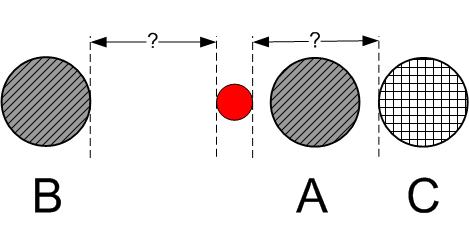updated 2023-02-25
Determining which boule is closest to the jack is at the heart of petanque. There are a number of different ways to do it.
[See also our post on Buying measuring tools.]
(1) VISUAL INSPECTION (aka “eye-balling”)
Visual inspection is the technique of first resort. The trick to being able to tell which of two boules is closer to the jack lies in where you stand. Don’t stand directly over the boules, looking down on them. Stand back from the boules a meter or more, so that you are the same distance from each of the boules. Look across the boules at the jack. Imagine a line between the boules, and imagine a second line extending out from center of that line. You will probably be able to see that the jack falls on one side of that second line; that is, you will probably be able to see that the jack is closer to one of the boules than the other.
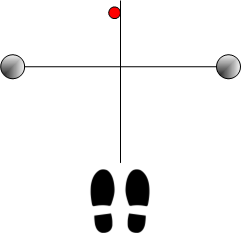
Visual inspection is fast and there is no danger of accidentally touching and moving anything. But it is not precise. When two boules are almost the same distance from the jack, it may not be possible to tell which is closer. Sometimes if you look across the boules to the jack, one boule looks closer… but if you walk around to the other side and look across the jack to the boules, the other boule looks closer. That is when you need to remember the old adage— “When in doubt, measure.”
(2) COMPARISON
In comparison we use some physical object whose length can be adjusted to compare the distances between the boules and the jack. Various objects can be used to make the comparison. The traditional Provençal method is to hold two sticks together, as in the photo below. A telescoping metal rod like an old radio antenna or a pointer will also do the job nicely.
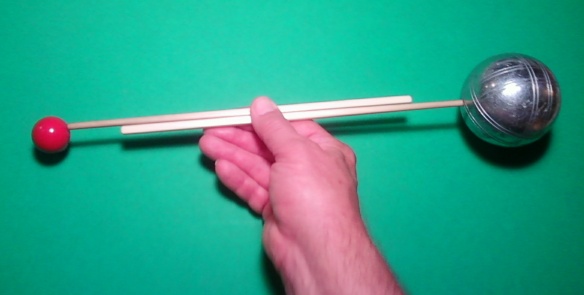
Chopstick calipers – a modern version of a traditional Provençal technique
Another traditional technique is to use a piece of string, as in the picture below. It is not a reliable technique. It is amazing how much the string mysteriously stretches depending on whose boules are being measured. Thanks to the Brighton-Hove Petanque Club and Pen-Y-Coed Petanque for several of the following photos.

One of the best comparison tools is a folding rule with an extensible end piece, commonly called an umpires rule. The photo below shows the correct way to hold the rule, with the butt against the boule and the slider extension toward the jack. NOTE that the rule is held with the unmarked side and the slider-control button facing upward. That way it is easy to use your left thumb to use the slider-control button to slide the extension in and out.
There is a trick to using an umpires rule. Do NOT position the rule between the boule and jack and then slowly push the extension toward the jack. If you do that, you may accidentally push the extension too far and touch and move the jack. Instead, hold the end of the rule ABOVE the jack while you are adjusting the extension, and then slowly lower the end of the rule down toward the jack. If you see that you are too long or too short, then lift the rule up again, adjust its length, and then again lower it down toward the jack. Repeat this process until you are satisfied with the measurement.

There is a kind of tape measure that is popular among bocce players; it is designed to be used as a comparison tool. Ignore the numbers on the tape. Extend it between the boule and jack, and lock it.

In petanque we measure the shortest distance between two objects. That means that if the objects are very close together and of greatly differing sizes (like a jack and a boule), the shortest distance is “tilted”.
When the distance is short and the plane of measurement is tilted in this way, you need to use a set of calipers.
 |
 |
 Some tape measures have a small built-in set of calipers. Some tape measures have a small built-in set of calipers. |

A folding rule can be used as a calipers. |
(3) MEASUREMENT

Comparison isn’t practical for longer distances. For longer distances, we need to measure, that is, to measure the distances between the jack and the relevant boules, and then compare the measurements. Measurement involves assigning numeric values to distances, which comparison does not.
The most common tool for measuring is a retractable steel tape measure. (See our page on buying measuring tools.) The proper way to use a tape is to measure across the top of the jack to the boule. Make sure that the end of the tape is positioned at the middle of the boule; if it it too high or too low, the measurement won’t be accurate. Keep the tape above the jack, without touching it. Look straight down at the jack, and measure to the edge (not the top) of the jack.
Measurement requires strong legs, steady hands, and good eyes. It is difficult to do. It requires squatting or kneeling and holding the tape measure steady, with two different parts of the tape microscopically close to boule and jack, then reading the numbers on the tape to the precision of one millimeter while avoiding distortions due to parallax. And of course, it creates a danger of bumping and moving the boule or the jack.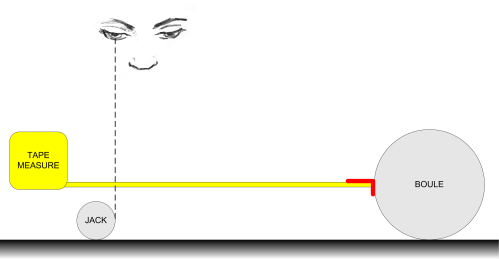

If the distance is long, get a friend to hold the end of the tape against the boule.

(4) DEVICE-ASSISTED VISUAL INSPECTION
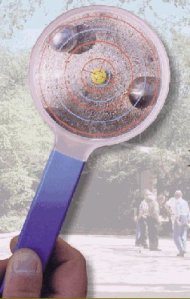
Le Juge
The first step along the path to device-assisted visual inspection took place around the year 2000 with a device called Le Juge (the Judge). It was a circular plastic lens with concentric lines painted on it. You centered the view on the jack, and (in theory) the concentric rings made it easy to determine the relative distances of the boules. Le Juge didn’t actually work very well, but the basic idea was quickly adapted for smartphone cameras.

There are a number of smartphone apps that work basically the same way that Le Juge worked. (See our post on smartphone apps for measuring.) The idea of smartphone-assisted visual inspection is extremely attractive. There is no risk of touching and moving boules or jack. You don’t need to squat or get down on your knees. Smartphones, now, are virtually ubiquitous. One issue is that, now, there are many different smartphone apps and they vary widely in reliability, accuracy, and ease of use.
Another device for visual inspection is a “laser tape measure”. These devices are widely used in construction, but as devices for making petanque measurements they are clumsy. A laser beam can’t see though intervening boules or through rocks or bumps on the terrain. And a laser tape measure is expensive compared to a old-fashioned tape measure.
SOME FINER POINTS
Before we end, we should mention a couple of the finer points of the art of measuring.
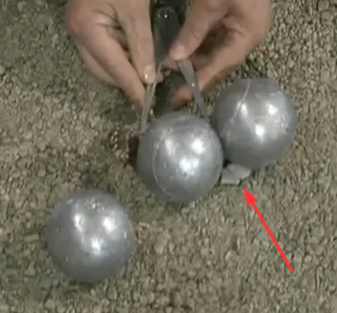 When the distances are close and an umpire wants to make sure that nothing is disturbed during the measuring, he/she can place wedges under boules. In this YouTube video we can see the umpire placing wedges and then measuring with calipers. In the video the jack is hidden behind the center boule and she is measuring the “second” boules to determine whether the winning team scored one point or two.
When the distances are close and an umpire wants to make sure that nothing is disturbed during the measuring, he/she can place wedges under boules. In this YouTube video we can see the umpire placing wedges and then measuring with calipers. In the video the jack is hidden behind the center boule and she is measuring the “second” boules to determine whether the winning team scored one point or two.
 Another standard item in an umpire’s toolkit is a set of feeler gauges, the kind that you would use when gapping spark plugs. An umpire will use them when there is daylight between boule and jack but they are so close that you can’t fit a calipers between them.
Another standard item in an umpire’s toolkit is a set of feeler gauges, the kind that you would use when gapping spark plugs. An umpire will use them when there is daylight between boule and jack but they are so close that you can’t fit a calipers between them.

Rather than declaring two boules to be equidistant from the jack, an umpire will resort to feeler gauges in an attempt to find that one boule is closer to the jack than the other. This makes ordinary players in friendly games wonder how precise their own measurements should be. My advice is— don’t be afraid to declare that two boules are equidistant from the jack. If both teams measure, and neither team is sure that one boule beats the other, then let it be. Agree that the boules are equidistant, the point is null, and carry on with the game.
FURTHER READING
- “Measuring distance between boules and the cochonnet” by former Southern Counties Petanque Association Regional Umpire Richard Powell is available HERE.
- The Petanque New Zealand “Umpire’s Training Manual” (2019) is available HERE.
